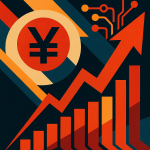May 7, 2025
Key Points
- China’s A-shares market surged, with the Shanghai Composite up 0.80% and turnover reaching nearly ¥1.5 trillion RMB ($208.33 billion USD) on the Shanghai and Shenzhen markets combined.
- The Aerospace (Hángtiān Hángkōng 航天航空) sector led gains, with other strong performers including Shipbuilding, Fertilizers, and Agriculture. Gaming (Yóuxì 游戏) was among decliners.
- The People’s Bank of China (PBOC) announced stimulus measures including a 0.5 percentage point RRR cut (injecting ~¥1 trillion RMB) and a 0.1 percentage point reduction in policy interest rates.
- The CSRC and NFRA emphasized market stability and increased institutional investment, with the NFRA planning to leverage insurance funds more effectively as long-term capital.
- Institutional outlooks from Minsheng Securities, Sinolink Securities, and Industrial Securities offer varied perspectives, with some highlighting potential relative value in Chinese assets, expected increased market “volatility,” and the return of the tech growth style.

Alright, let’s dive into the big news from China’s financial playground. Today, the Chinese A-shares market showed some serious muscle, with key indices painting the town green. We’re talking significant upward movement and a whole lot of cash changing hands. If you’re watching Chinese tech and market trends, this is one for the books.
So, what’s driving the buzz? Let’s break it down.

Resume Captain
Your AI Career Toolkit:
- AI Resume Optimization
- Custom Cover Letters
- LinkedIn Profile Boost
- Interview Question Prep
- Salary Negotiation Agent

Market Snapshot: The Numbers Don’t Lie
The three major stock indices for China’s A-shares (A-gǔ A股) all wrapped up the day on a high note:
| Index | Chinese Name | Change (%) |
|---|---|---|
| Shanghai Composite Index | Hùzhǐ 沪指 | 0.80 |
| Shenzhen Component Index | Shēnzhèng Chéngzhǐ 深证成指 | 0.22 |
| ChiNext Index | Chuàngyèbǎn Zhǐ 创业板指 | 0.51 |
- The Shanghai Composite Index (Hùzhǐ 沪指) jumped up by 0.80%.
- The Shenzhen Component Index (Shēnzhèng Chéngzhǐ 深证成指) saw an increase of 0.22%.
- And the ChiNext Index (Chuàngyèbǎn Zhǐ 创业板指), often a bellwether for tech and growth stocks, gained a solid 0.51%.
But here’s a real kicker: the combined turnover for the Shanghai and Shenzhen stock markets (Hù Shēn liǎng shì 沪深两市) was nearly ¥1.5 trillion RMB ($208.33 billion USD). That’s a hefty increase of about ¥130 billion RMB ($18.06 billion USD) from the previous trading day, signaling strong investor activity and liquidity in the market.
- Combined Turnover: Nearly ¥1.5 trillion RMB ($208.33 billion USD)
- Increase from Previous Day: Approximately ¥130 billion RMB ($18.06 billion USD)
- Total Stocks with Price Climb: Nearly 3,300
- Stocks Hitting Daily Limit Up: Over 100

Sector Spotlight: Who’s Winning and Who’s…Not?
It wasn’t just a broad-stroke rally; some sectors absolutely popped off today.
Leading the Charge:
- The Aerospace (Hángtiān Hángkōng 航天航空) sector experienced a significant surge. This is a big one, and we’ll touch on individual players shortly.
- Other top performers included:
- Shipbuilding (Chuánbó Zhìzào 船舶制造)
- Fertilizers (Huàféi Hángyè 化肥行业)
- Agriculture, Animal Husbandry, and Fishery (Nóng Mù Sì Yú 农牧饲渔)
- Chemical Raw Materials (Huàxué Yuánliào 化学原料)
- Rubber Products (Xiàngjiāo Zhìpǐn 橡胶制品)
- Mining Industry (Cǎijué Hángyè 采掘行业)
Taking a Hit:
- The Gaming (Yóuxì 游戏) sector was among the notable decliners. Keep an eye on this space if it’s in your portfolio.
Drilling down to individual stocks, nearly 3,300 stocks saw their prices climb, with over 100 hitting their daily limit up – that’s a bullish signal! In the booming Aerospace sector, Chenxi Aviation (Chénxī Hángkōng 晨曦航空) was a standout, rocketing up by 19.96%. Over in Shipbuilding, Tianhai Defense (Tiānhǎi Fángwù 天海防务) also had a good day, rising by 6.86%.

Find Top Talent on China's Leading Networks
- Post Across China's Job Sites from $299 / role, or
- Hire Our Recruiting Pros from $799 / role
- Qualified Candidate Bundles
- Lower Hiring Costs by 80%+
- Expert Team Since 2014
Your First Job Post

Key Financial Headlines Shaking Things Up
Several major announcements dropped today, and they’re definitely fueling some of this market optimism. Let’s unpack them:

ExpatInvest China
Grow Your RMB in China:
- Invest Your RMB Locally
- Buy & Sell Online in CN¥
- No Lock-In Periods
- English Service & Data
- Start with Only ¥1,000

PBOC Unleashes Liquidity: RRR Cut, Rate Reductions
This is a big one. Pan Gongsheng (Pān Gōngshèng 潘功胜), Governor of the People’s Bank of China (Zhōngguó Rénmín Yínháng 中国人民银行) (PBOC), dropped some major policy news at a State Council Information Office (Guó Xīn Bàn 国新办) (SCIO) press conference.
- Reserve Requirement Ratio (RRR) Cut: 0.5 percentage points (Expected to inject ~¥1 trillion RMB / ~$138.89 billion USD liquidity)
- Policy Interest Rate Lowered: 0.1 percentage points (7-day reverse repo rate from 1.5% to 1.4%)
- Anticipated LPR Impact: Reduction of about 0.1 percentage points
- Reserve Requirement Ratio (RRR) Cut: A 0.5 percentage point cut in the RRR is on the way. This is expected to inject around ¥1 trillion RMB ($138.89 billion USD) in long-term liquidity into the market. More money flowing means more potential for investment and economic activity.
- Policy Interest Rate Lowered: Policy interest rates are getting trimmed by 0.1 percentage points. Specifically, the 7-day reverse repo rate will drop from 1.5% to 1.4%.
- LPR Impact: This move is anticipated to lead to a similar reduction of about 0.1 percentage points in the Loan Prime Rate (Dàikuǎn Shìchǎng Bàojià Lìlǜ 贷款市场报价利率) (LPR), which can lower borrowing costs for businesses and individuals.
These moves by the PBOC are classic stimulus measures, designed to make borrowing cheaper and encourage spending and investment. Definitely a positive signal for the markets.

CSRC Emphasizes “Reliability” in Capital Markets
Wu Qing (Wú Qīng 吴清), Chairman of the China Securities Regulatory Commission (Zhèngjiānhuì 证监会) (CSRC), had a clear message: “reliability” is the cornerstone of China’s capital market.
He underscored that with reliable economic development, macroeconomic policies, and institutional guarantees, the capital market is adding more certainty to the economy.
Wu stated, “In this uncertain market environment, there will be winds and rain on our way forward…we have the confidence, conditions, and ability to achieve the stable and healthy development of China’s stock market.”
This kind of assurance from the top regulator is aimed squarely at boosting investor confidence, especially when global markets can be a bit shaky.

Sino-US Economic Talks: A Glimmer of Dialogue
On the international front, there’s a development in Sino-US economic and trade relations. China has decided to engage with the U.S. after considering global expectations and calls from the U.S. business community.
Vice Premier He Lifeng (Hé Lìfēng 何立峰), who leads these negotiations for China, is set to hold talks with his U.S. counterpart, the U.S. Secretary of the Treasury, during his visit to Switzerland.
While it’s early days, any dialogue between the two economic giants is generally seen as a positive step towards potentially easing trade tensions.

NFRA: Boosting Insurance Funds’ Market Role
Li Yunze (Lǐ Yúnzé 李云泽), Director of the National Financial Regulatory Administration (Jīnróng Jiānguǎn Zǒngjú 金融监管总局) (NFRA), announced plans to leverage insurance funds more effectively as patient, long-term capital in the market.
- Expand Pilot Scope for Long-Term Investment
- Reduce Risk Factor for Stock Investments by Insurance Companies: 10%
- Promote Long-Term Assessment Mechanisms
Here’s the game plan:
- Expand Pilot Scope: Broaden the pilot program for long-term investment by insurance funds. This aims to inject more incremental capital into the market.
- Adjust Solvency Rules: Further reduce the risk factor for stock investments by insurance companies by 10%. This is a direct incentive for insurers to increase their market participation.
- Promote Long-Term Assessment: Encourage long-term investment horizons through new assessment mechanisms.
These measures could bring more stable, long-term money into the A-share market, which is often seen as a stabilizing force.

Geopolitical Murmurs: India-Pakistan Tensions & Defense Stocks
Adding a layer of geopolitical complexity, media reports cited by CCTV News (Yāngshì Xīnwén 央视新闻) indicate an escalation in India-Pakistan tensions.
Pakistani media reported its Air Force shot down six Indian fighter jets. India’s NDTV reported its military used Rafale fighters in an airstrike, with Pakistan claiming to have downed two.
Separately, it was noted that a major defense industry stock, valued at ¥190 billion RMB ($26.39 Billion USD), experienced a surge. While a direct causal link to this specific conflict wasn’t explicitly stated in this brief, geopolitical tensions often lead to increased investor interest in defense-related equities.

Institutional Crystal Ball: What the Big Firms Are Saying
So, what do the pros think about where things are headed? Here’s a peek at some institutional outlooks:

Minsheng Securities: Chinese Assets Still a Good Bet?
Minsheng Securities (Mínshēng Zhèngquàn 民生证券) offers a nuanced view:
- Trade Tensions: While some signs point to easing U.S.-China trade friction, unresolved issues (like U.S.-Japan or U.S.-Europe talks) could still stir market volatility.
- Relative Value: Regardless of how trade talks pan out, Minsheng believes Chinese assets may offer better relative value. This is a key insight for global investors weighing their options.
- Resilience vs. Speculation: The strength of fundamentals is there, but how long stabilization forces and structural shifts in speculative capital will last is uncertain.
- Not a Blanket Rally: The recovery of Chinese assets doesn’t mean everything goes up. Domestic demand and the reshaping global economic order are key drivers.
- Recommendations:
- Consumer Sectors: Tourism, dairy, food, beer, custom home furnishings, cosmetics, apparel, retail (all benefiting from China’s domestic demand).
- Global Reshuffle Winners: Resource commodities (copper, aluminum, gold) and capital goods (construction machinery, steel, automation, chemicals).
- Defensive Plays: Undervalued financials (banks, insurance) and coal (for internal consumption + dividends) to hedge against external shocks.

Sinolink Securities: Brace for “Volatility” Upswing
Sinolink Securities (Guójīn Zhèngquàn 国金证券) expects market “volatility” to trend upwards. Here’s their take:
- Market Shift: Expect a rotation from small and mid-cap growth stocks to large-cap value defensive plays, at least through Q1, until an “earnings bottom” is clearer.
- Market Bottom Established: With the A-share “market bottom” likely in, and AI industry logic as a catalyst, tech growth should still offer structural opportunities.
- May Sector Allocation: Growth is diverging; value will gradually gain an edge.
- Reduce exposure to AI edge applications driven purely by liquidity/sentiment (especially those with “penetration rates below 10%”).
- Increase allocation to tech growth with solid earnings contributions or potential, including:
- Optical chips, smart cockpits, GPUs, new display tech.
- AI infrastructure (benefiting from industry Capex and domestic fiscal support).
- Overweight: Major telecom operators, infrastructure, “growth-oriented dividend” assets (like consumer staples).
- Gold Stocks: Could see a “Davis double-click” (P/E expansion + earnings growth) due to rising gold prices.
- Innovative Drugs (Chuangxinyao 创新药): Short-term margin improvement and IRR recovery look promising, with long-term revenue potentially improving too.

Industrial Securities: Is Tech Growth Making a Comeback?
Industrial Securities (Xīngyè Zhèngquàn 兴业证券) flagged the return of the tech growth style:
- Timing is Right: With domestic financial reports out and external tariff issues fading, the moment for investing in tech growth is approaching. TMT (Technology, Media, Telecom) leading A-share gains recently supports this.
- Why the Shift?
- Attractive Valuations: The tech sector looks good value-wise after a significant prior correction. Indicators like rolling return differentials and trading volume share suggest the adjustment in tech style has been thorough.
- Sentiment Improving: As earnings/tariff disturbances ease and pessimism fades, the tech sector—strong in both economic prosperity and industrial trends—is regaining investor focus.
- Key Takeaway: Tech, with its dual advantages, is becoming a primary target for capital once again.
The Chinese A-shares market is clearly dynamic, with policy levers, sector-specific strengths, and global factors all playing a part. Staying informed on these developments is crucial for anyone invested or interested in this major global market.

FAQs
What are A-shares in the Chinese stock market?
A-shares (A-gǔ A股) are shares of mainland China-based companies that are traded on Chinese stock exchanges, like the Shanghai Stock Exchange and the Shenzhen Stock Exchange. Historically, they were primarily available to domestic investors, but access has been gradually opening up to foreign investors through programs like QFII, RQFII, and Stock Connect.
What does an RRR cut by the PBOC mean for the market?
An RRR (Reserve Requirement Ratio) cut means the People’s Bank of China (PBOC) is allowing commercial banks to hold a smaller percentage of their deposits in reserve. This frees up more money for banks to lend, injecting liquidity into the financial system. It’s generally seen as a move to stimulate economic activity and can be positive for stock markets as it can lead to increased investment and easier access to credit.
Why is the Aerospace sector surging in China?
While this specific article notes a surge led by stocks like Chenxi Aviation (Chénxī Hángkōng 晨曦航空), the exact reasons for a sector-specific surge can be multi-faceted. It could be due to positive earnings reports, new government contracts or support, technological breakthroughs, increased defense spending (especially if linked to geopolitical events), or broader strategic initiatives by the Chinese government focusing on aerospace development.
How do Sino-US trade talks impact the Chinese stock market?
Sino-US trade relations are a significant factor for the Chinese (and global) economy. Positive developments, like planned talks or agreements, can boost investor confidence, reduce uncertainty, and lead to market rallies, particularly for export-oriented companies. Conversely, escalating tensions or new tariffs can have a negative impact, increasing volatility and potentially leading to market downturns.
What do institutional outlooks tell us about market trends?
Institutional outlooks from firms like Minsheng Securities, Sinolink Securities, and Industrial Securities provide insights from professional analysts who closely monitor market data, economic indicators, and policy changes. They offer perspectives on potential market direction, sector performance, investment strategies (like value vs. growth), and risk factors. While not guarantees, these outlooks can help investors understand prevailing sentiments and potential future trends.
References
Source: Eastmoney Choice Data (Dōngfāng Cáifù Choice Shùjù 东方财富Choice数据)




